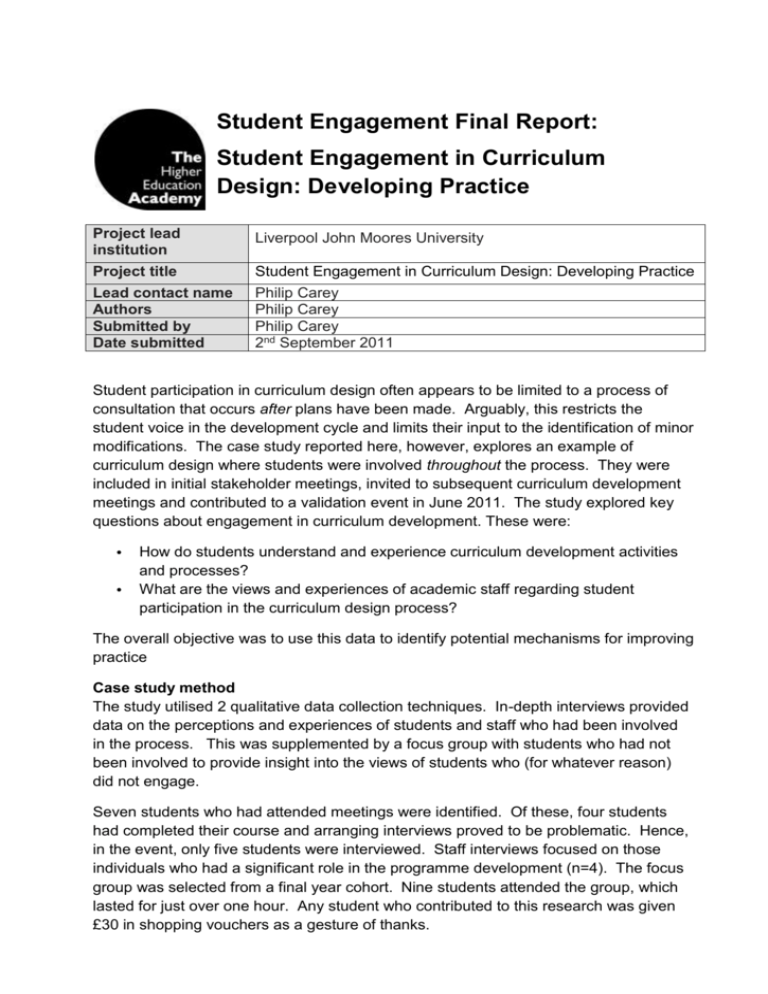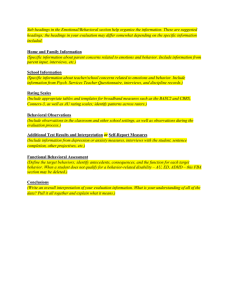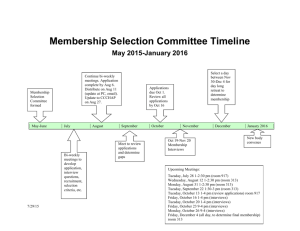views - Sparqs
advertisement

Student Engagement Final Report: Student Engagement in Curriculum Design: Developing Practice Project lead institution Liverpool John Moores University Project title Student Engagement in Curriculum Design: Developing Practice Lead contact name Authors Submitted by Date submitted Philip Carey Philip Carey Philip Carey 2nd September 2011 Student participation in curriculum design often appears to be limited to a process of consultation that occurs after plans have been made. Arguably, this restricts the student voice in the development cycle and limits their input to the identification of minor modifications. The case study reported here, however, explores an example of curriculum design where students were involved throughout the process. They were included in initial stakeholder meetings, invited to subsequent curriculum development meetings and contributed to a validation event in June 2011. The study explored key questions about engagement in curriculum development. These were: • • How do students understand and experience curriculum development activities and processes? What are the views and experiences of academic staff regarding student participation in the curriculum design process? The overall objective was to use this data to identify potential mechanisms for improving practice Case study method The study utilised 2 qualitative data collection techniques. In-depth interviews provided data on the perceptions and experiences of students and staff who had been involved in the process. This was supplemented by a focus group with students who had not been involved to provide insight into the views of students who (for whatever reason) did not engage. Seven students who had attended meetings were identified. Of these, four students had completed their course and arranging interviews proved to be problematic. Hence, in the event, only five students were interviewed. Staff interviews focused on those individuals who had a significant role in the programme development (n=4). The focus group was selected from a final year cohort. Nine students attended the group, which lasted for just over one hour. Any student who contributed to this research was given £30 in shopping vouchers as a gesture of thanks. Analysis This analysis focuses on themes gathered from scrutiny of student interviews. Staff and focus group data has been used to establish convergence or divergence from these and illuminate shared or opposing perspectives. Gender-neutral pseudonyms have been allocated to individual students to protect anonymity. The themes identified centred on: 1. motivation for attending meetings 2. perceptions of management of meetings 3. Reaction to meetings Motivation for attending meetings All students were personally invited to meetings. No-one recalled open invitations to all students to volunteer. This was supported in focus group discussions, with these students being unaware of any involvement in course development. Students who attended had a history of engagement. All were mentors and three were student representatives. However, the latter were l unsure as to whether they had been asked to attend in this role or as an interested individual. Most students were in their final year and recognised that it was too late for them to personally benefit from any developments in their curriculum. Despite this, they had welcomed the chance to participate and saw it as symbolic of how much the course team cared about their students. All attendees wanted to share their experiences as they felt that these offered insight into how the course could be enriched for future students. Behind this was a notion of altruism and not personal gain, as Ronnie commented, “I think a lot of the stuff that we do in the university is not going to impact on us…because the business plan for the university isn’t for one term, it isn’t one year, it’s not even three years. It’s a long ball game isn’t it? So a lot of the changes that come about will be several years down the line when I am driving past [the university] and it’s a distant memory.” This was also discussed by students in the focus group who recognised that their learning had benefitted from the feedback of previous students. Having their views heard had been an important incentive for attendance at meetings. However, this often centred on frustrations with aspects of their learning experience and the desire to see these changed for future cohorts . Bernie commented on how this motivation had not been shared by all of their peers, “They were just focused on doing the assignments and they were like, “what are you doing it for Bernie? It’s over now, it doesn’t matter” - but it did to me” It was acknowledged that this had led to students’ contributions being characterised by complaint; an observation that was also evident in staff interviews. Charlie felt that this had skewed the nature of commentary that course teams received, “I think the people with the good experiences don’t have anything to say, whereas the people with the bad experiences were quite passionate about improving the system for the next students”. A consequence of this was that meetings tended to revisit previously identified grievances. Staff felt that they had heard it before and students reported feeling frustrated by the lack of previous activity. “To be honest I got the impression it was stuff that had been said to them before. Which kind of makes me think ‘OK great – if it’d been mentioned by previous cohorts in previous years, why hadn’t it been resolved by the time we got to that stage?’” (Ronnie) Another consequence of a complaint-based focus was that meetings came to be dominated by issues that had historically challenged the course. In this instance, these related to work-based learning. It was recognised in both staff and student interviews that the spotlight on this had sidelined debate about other aspects of the learning experience. However, one member of staff questioned whether this may have been a strategy used by students to avoid confrontation with tutors over their teaching and assessment practices. The emphasis on students raising concerns meant that no student reported being involved in exploring possible solutions to problems. There was a view that they were reacting to an agenda set by the programme team and that other priorities may have been lost. As a result, some students viewed the process with a touch of cynicism. They felt that it had been a paper exercise that had exposed few new observations. Yet, this scepticism was not universal. Drew, for example, was characteristic of having generally enjoyed the meetings, but had also seen them as a chance to learn about other perspectives, “I really enjoyed them because you could actually meet staff on a sort of equal footing. You could have an interesting discussion from their perspective and your perspective as to how things are done and you get a bigger insight. There is so much more below the surface from what you see as a student - what goes on and what the lecturers have to deal with.” Perceptions of management Academic staff were generally judged to have been constructive, willing to listen and supportive. Nevertheless, hostility from a few had undermined the process. This was also commented on in staff interviews, with the behaviour of a small minority of colleagues seen as inappropriate and rude. However, no-one was whether this had been aimed students specifically or reflected some other frustrations. Nevertheless, it had upset some of the students, as Pat commented, “Most of the lecturers were great, but I think one or two lecturers either didn’t want to be there or they felt that we deliberately misinterpreted what we heard on certain points - almost like we fed back the wrong information...To me it was a really important set of meetings. Yes it’s the lecturer’s work, but it’s the career and lives of students. To see lecturers who are not really bothered, because their body language was clearly that they didn’t want to be there, or for them to get up half way through to go to another meeting is disrespectful to fellow colleagues as well as the students.” (Pat) This had stifled debate, but another impediment was the composition of meetings. All respondents felt that the ratio of staff to students (at around 6:1) was too high. They also commented on the formality of meetings and the presence of ‘the higher ups’ managers who they felt they had little connection with. For a couple of attendees, this had been a little overwhelming, “It was quite formal. I didn’t expect it to be as formal, but I suppose they would listen to us more if it was a bit formal…I thought there would be more students as well. I felt like there was 12 people listening to my little voice and my opinions. It was a bit embarrassing really!” (Charlie) This was also explored in staff interviews, where several suggestions were made for how meetings could have been less traditional and more student-centred. There was also recognition from both students and staff that power relation may have inhibited discussion, as Bernie reflected, “…to criticise was quite hard because I didn’t want to cause any offence - and it was not meant personally. They are your tutors and you are a student and it comes back to that power thing. Plus the fact that it’s the end of the course, you’ve got 3 assignments to get in and you don’t want to create havoc with people. I know it’s silly and they probably wouldn’t even have thought of that, but it does go through your head that you don’t want to stand out and make a nuisance of yourself.” (Bernie) The focus group reflected similar concerns, with power and fear of punishment being a massive disincentive to offer tutors feedback and comment. With respect to this, they discussed the idea of staff acting as advocates for students. These individuals would not be associated with the teaching team and would offer a safe space where students could raise concerns for the university to address. Understanding the purpose Students reported that they had not fully understood the function of the meetings. They hadn’t heard of such engagement before little had been collectively addressed within their cohorts. As a result, some wondered whether their invitation had been strategic or ‘off-the-cuff’. They weren’t really sure if they were expected to speak for themselves or for their cohort, although all reported efforts gather the views of fellow students and represent these in meetings. From staff interviews, it was apparent that a decision had been made to broaden the range of voices present by extending invitations beyond course representatives. The language used in meetings was another source of confusion. Student interviews and focus group data, for instance, suggested a perception of ‘curriculum’ as a fairly straightforward entity related the management of a syllabus. Staff, on the other hand, had a more holistic perspective of this as content, process and assessment. The interviews provided no commentary on any efforts to identify and resolve differing views. Indeed, it appeared that staff use of a specific vocabulary of curriculum language had mystified concepts and was potentially alienating, “There were certain bits when I could have done with a dictionary. Like S.O.Rs? D.T.As. What do they mean? They blew a few of us out of the water with that. It was almost like we would put our point across as students, and then we’d start looking at each other as lecturers talked across the table using these acronyms and abbreviations and we are going – ‘OK then, what is that language of theirs?’ It’s almost they were translating it into something of higher meaning – that was a bit off-putting to say the least.” (Pat) Finally, no student was aware of the impact of their input on the eventual programme. At the time of interview, the process was not complete, but respondents wanted the feedback loop closed. Staff appeared to be unaware of the preference for ongoing information, citing the upcoming validation as the appropriate location for feedback. For different reasons, the feedback had also tested the focus group. They felt that there were insufficient mechanisms (or effort) for the university or individual staff to keep students informed of the reaction to feedback. This had been read as either a lack of interest or a lack of action and, consequently, discouraged students from providing further comment. Lessons learned In this example of curriculum develop the course team had attempted to extend student engagement beyond typical mechanisms. Students clearly appreciated these efforts, although there were limitations to the approach. Key to this was the focus on students’ complaints that may be indicative of a narrow view of their capacity. It suggests that the students’ role is to signal when and where something had gone wrong, leaving the process of fixing the problem to the academic staff. Ironically, some issues were of an enduring nature and staff expertise had failed to reach a solution. In contrast, students could have offered significant intelligence on what works, as well as what fails, but this was not explored. The implication is that, in spite of efforts to move beyond prevailing practice, mechanisms for engagement remained rooted in tradition. This was also illustrated by the decision to work with students in the context of standard processes and procedures. Formal meetings exemplify this. If paid staff appear to be frustrated with meetings, why would we expect students to volunteer to attend? Whilst meetings were generally perceived to have been friendly and supportive, they were not seen as a studentcentred method. Yet, these processes challenge the customs of academia. Academics are used to having control, and arguably this is necessary for effective teaching and assessment. Yet, engagement requires a greater sharing of power. To address this, students could be encouraged to manage engagement mechanisms themselves. Then, contrary to the current situation, staff would be invited as guests into this process. This could also respond to disquiet over how safe students feel in raising concerns, perhaps taking forward the idea of staff from outside the programme acting as a listening ear and advocate for students. This links to a broader issue. Engagement is not a one-off exchange, but an ongoing conversation that should characterise the whole student experience. There is little value waiting until for a curriculum overhaul before asking for students’ opinions. Although the students who engaged in this process had a history of participation, focus group data proved that they are not unique in wanting to participate. Rather, their previous engagement experiences may have empowered them to contribute. Universities have a range of formal processes related to engagement and making these more accessible and attractive to all students could therefore promote greater involvement in curriculum development. However, students need to see the benefit of participation for this to be effective. Sadly, as the students in this study noted, all too often feedback is received without comment or (at times) clear action. An engagement culture needs to happen inside as well as outside the classroom. In this way, engagement in curriculum development extends beyond the design phase and into operation of the learning and assessment strategy. For example, planning ideas could be integrated into assessment processes, thus incentivising and rewarding students for their efforts. It seems fitting to finish this report with the words of Drew, who contemplated on how to encourage greater student participation by articulating a notion of engagement in design through curriculum operation, “…it’s sort of like a mixture of teaching methods – making sure that every single student feels engaged. …you could do group study sessions to build the design [of the curriculum] into the curriculum so that it was part of learning. That way they would have actually got an insight into the design and it would be there’s too.”






